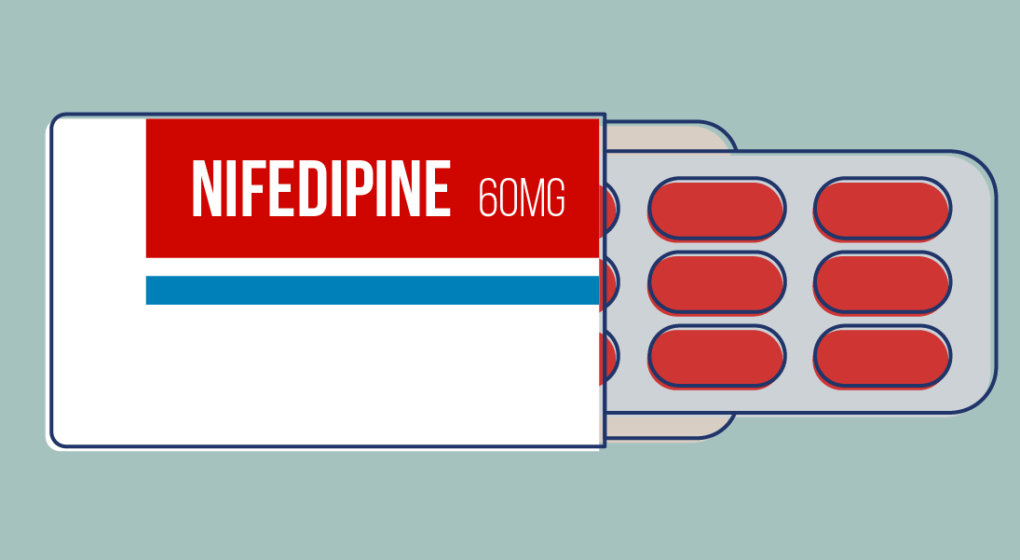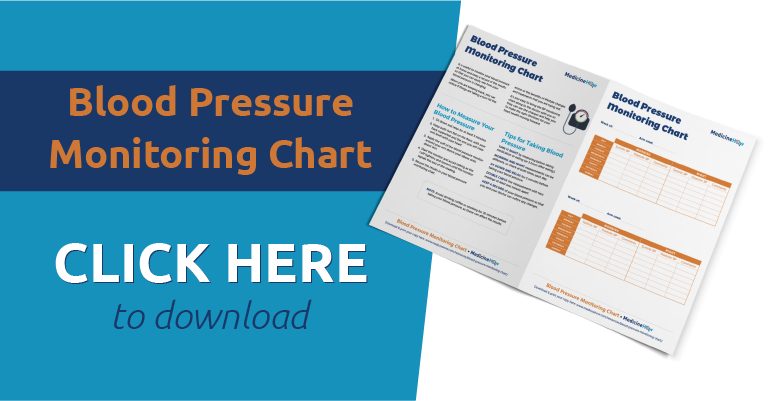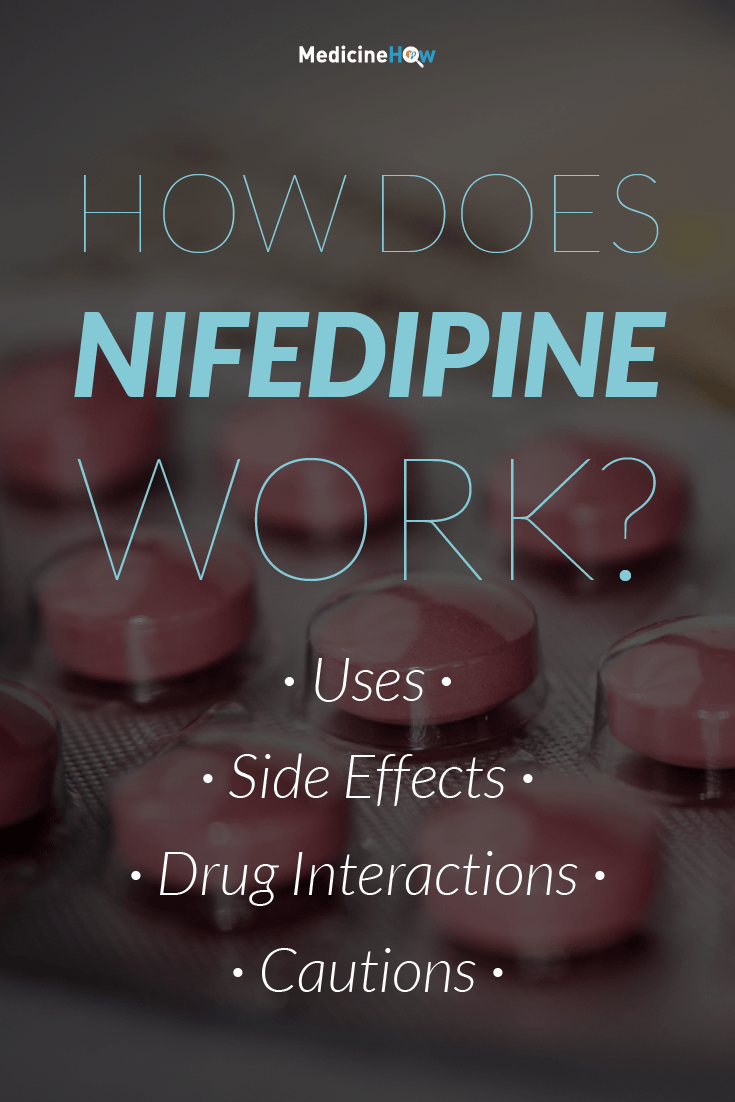
Nifedipine is a type of drug called a calcium channel blocker, which works to reduce blood pressure by relaxing the muscles around the blood vessels. If you or someone you know is taking amlodipine and you’d like to know more about how it works, this is for you.
Doses and Brand Names
![]() Nifedipine is the generic name – the name of the actual drug component inside your medication. The brand name written on the packaging might be slightly different such as:
Nifedipine is the generic name – the name of the actual drug component inside your medication. The brand name written on the packaging might be slightly different such as:
- Adalat
- Adalat Oros
- Addos
- Addos XR
- Adefin
- Adefin XL
- Nifehexal
All of these medications contain the same drug and do exactly the same thing – they are just manufactured by different companies.
Each brand comes in several different doses, usually 10, 20, 30 and 60 mg. When starting nifedipine medication for the first time, it is best to begin with a low dose, such as 10mg and gradually increase the dose and until it is working as it should be. This helps to decrease the risk of any side effects as your body adjusts to the drug.
What does the Oros, XR and XL mean? They simply mean the drug has been formulated in a special way so that it works for a longer period of time. You body is very efficient and eliminating nifedipine – if you take a 30 mg dose in the morning, only half will be left by lunchtime and by bedtime less than 1 g will be left in your body. This is why you need to take two doses each day with a standard dose, or simply once a day with the Oros, XR or XL doses.

What type of drug is it?
![]() Nifedipine is a type of drug called a dihydropyridine calcium channel blocker. This is a drug class that helps us to group drugs that work in a similar way together. Other drugs in the same class are:
Nifedipine is a type of drug called a dihydropyridine calcium channel blocker. This is a drug class that helps us to group drugs that work in a similar way together. Other drugs in the same class are:
It is a special type of calcium channel blocker, called a dihydropyridine calcium channel blocker. This simply means that is has a more profound effect on the blood vessels and less on the heart.
What is it used for?
![]() The most common use of nifedipine is for someone with hypertension, or high blood pressure. This is because it works very well to reduce the blood pressure due to the way it works.
The most common use of nifedipine is for someone with hypertension, or high blood pressure. This is because it works very well to reduce the blood pressure due to the way it works.
Sometimes it can also be used to help people with angina to prevent future attacks. Usually it is used in combination with a drug to help prevent clots, like aspirin or clopidogrel, and other anti-hypertensive medications.
Unlike other calcium channel blockers, nifedipine is occasionally used in preterm labour to relaxing the uterus and preventing preterm labour. This is an accepted use, but there isn’t much scientific research to back up its use.
How does Nifedipine work?
![]() Calcium is very important in the body and is needed to allow some muscles to contract. In particular, smooth muscles that you don’t have any conscious control over, like those in your heart and that surround your blood vessels, rely on calcium.
Calcium is very important in the body and is needed to allow some muscles to contract. In particular, smooth muscles that you don’t have any conscious control over, like those in your heart and that surround your blood vessels, rely on calcium.
Calcium channel blockers like amlodipine work by blocking the passage of calcium into the cells. When the calcium is blocked the muscles can’t contract properly.
For someone with hypertension, this is actually a good thing. High blood pressure means there is too much blood pumping around the body too fast, putting a lot of pressure on the heart and the rest of the cardiovascular system. Nifedipine allows the blood vessels to relax and expand slight, letting the blood flow through more easily.
Side Effects
![]() The most common side effects of nifedipine happen because the drug is working too well – instead to high blood pressure, you end up with low blood pressure. Signs of low blood pressure are:
The most common side effects of nifedipine happen because the drug is working too well – instead to high blood pressure, you end up with low blood pressure. Signs of low blood pressure are:
- Headache
- Tiredness
- Dizziness
- Flushing
If you notice these signs, it is likely that the dose of nifedipine is too high. It is best for you to discuss this with you doctor, who will help you to find the right dose.
Nifedipine can also sometimes cause retention of fluid in your body, making your ankles appear swollen. This is called oedema and usually means the amlodipine dose is too high – if you notice this, it’s best that you discuss your symptoms with your doctor as soon as possible.
Cautions
![]() Nifedipine is supposed to be taken long-term to help you to control your blood pressure. If you stop taking it suddenly, the smooth muscles around your blood vessels will suddenly be able to contract again and will tighten to cause rebound hypertension.
Nifedipine is supposed to be taken long-term to help you to control your blood pressure. If you stop taking it suddenly, the smooth muscles around your blood vessels will suddenly be able to contract again and will tighten to cause rebound hypertension.
Rather than stopping cold turkey, it is best to gradually reduce the dose over time to allow your body time to readjust. If you are currently taking 10mg, your doctor might reduce your dose to 5 mg, then you can take half a 5 mg tablet (2.5 mg) for a some time before stopping completely.
You might also find that amlodipine affects your mental coordination – you might feel more tired than usual and lack alertness. If this happens to you, you should avoid driving or operating heavy machinery as the consequences if you lose concentration could be disastrous.
Drug Interactions
![]() When you take nifedipine together with other drugs the way they work can interact, changing their effect on your body. There are several drugs that interact with nifedipine, including:
When you take nifedipine together with other drugs the way they work can interact, changing their effect on your body. There are several drugs that interact with nifedipine, including:
- Cimetidine increases the concentration of nifedipine and there is a greater risk of side effects. Usually another drug is used instead of cimetidine, but it would also work to decrease the dose of nifedipine.
- Digoxin concentration can increase when taken with nifedipine. If you notice side effects, such as slow heart beat, your digoxin dose may need to be lowered.
- Fluconazole stops nifedipine from being metabolized as usual, increasing its concentration risk of side effects. If you experience signs of low blood pressure, you should talk to your doctor about lowering your nifedipine dose.
- Indinavir increases the concentration of nifedipine and the risk of side effects. If you experience signs of low blood pressure, you should talk to your doctor about lowering your nifedipine dose.
- Itraconazole also stops your body from breaking nifedipine down in the liver as normal. Additionally, both drug increase risk of heart failure due to an inotropic effect. It’s best to avoid this combination, but is some cases it is used with a lower nifedipine dose than normal.
- Magnesium Sulfate effects are more profound when taken with nifedipine and there is a risk of hypotension. They are occasionally used together, but need to be monitored closely and the magnesium dose may need to be decreased.
- Rifampicin stops nifedipine from being metabolized as usual, increasing its concentration risk of side effects. If you experience signs of low blood pressure, you should talk to your doctor about lowering your nifedipine dose.
- Tacrolimus concentration may increase when taking nifedipine at the same time, increasing risk of side effects. If side effects occur, the tacrolimus dose can be decreased.

Special Cases
![]() When nifedipine enters your body, your body recognizes it isn’t supposed to be there are tries to get rid of it – it is for this reason that you need to take a tablet each day. The way your body does this is by changing it with a chemical reaction in the liver and afterwards it is excreted in your urine.
When nifedipine enters your body, your body recognizes it isn’t supposed to be there are tries to get rid of it – it is for this reason that you need to take a tablet each day. The way your body does this is by changing it with a chemical reaction in the liver and afterwards it is excreted in your urine.
Your liver function is very important for processing nifedipine. If you have a hepatic impairment, you may not be able to process the drug as efficiently as usual. For some people, simply taking a lower dose is enough to address this but for others a different choice of drug might be a better option.
Pregnancy and Breastfeeding
![]() All dihydropyridine calcium channel blockers, including nifedipine should be avoided if you are pregnant or planning to become pregnant soon. This is because it can cause maternal hypotension and lead to insufficient oxygen supply to your baby.
All dihydropyridine calcium channel blockers, including nifedipine should be avoided if you are pregnant or planning to become pregnant soon. This is because it can cause maternal hypotension and lead to insufficient oxygen supply to your baby.
For women who are breastfeeding, however, nifedipine can be used safely. Less the 5% of the drug is excreted in breast milk, which is unlikely to have an effect on your baby. It is a good idea to monitor for signs of hypotension in your baby just in case, however.


